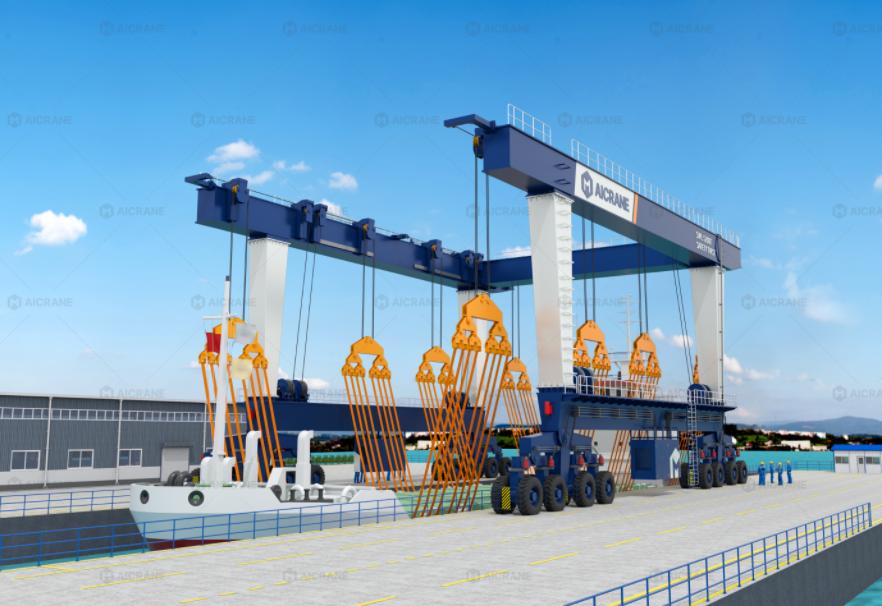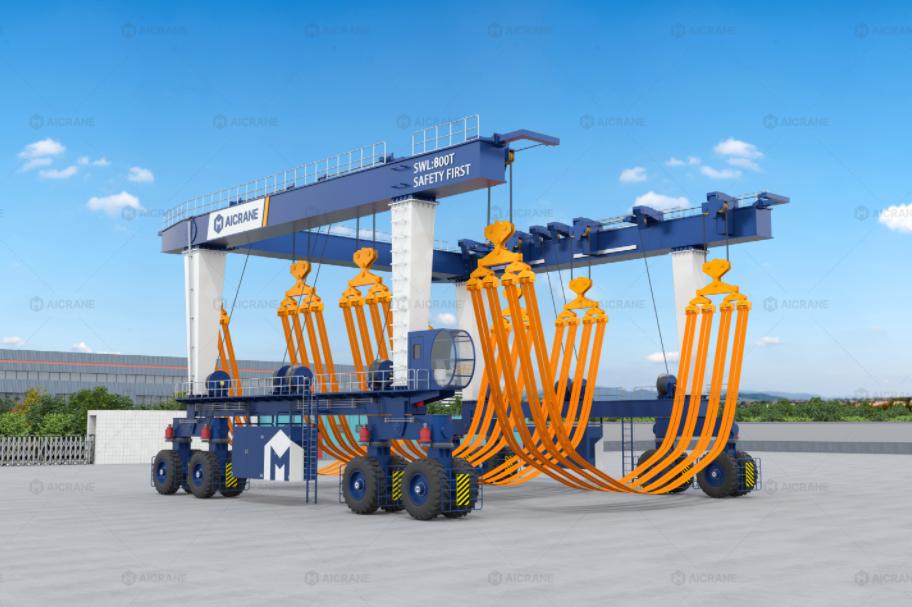Anti-Corrosion Strategies for Boat Gantry Cranes in Coastal and Marine Environments
Boat gantry cranes are vital equipment for shipyards, marinas, and boat maintenance facilities. They enable the safe and efficient lifting, transportation, and storage of boats and yachts of various sizes. However, in coastal and marine environments, these cranes are exposed to some of the harshest conditions imaginable, including salt-laden air, high humidity, and fluctuating temperatures. These factors significantly accelerate the corrosion of structural steel, electrical components, and mechanical systems, potentially reducing operational lifespan and increasing maintenance costs. Therefore, implementing robust anti-corrosion strategies is crucial to ensure safety, reliability, and longevity.
This article explores comprehensive anti-corrosion strategies for boat gantry cranes in coastal and marine environments, addressing design, material selection, protective coatings, maintenance practices, and monitoring technologies.

1. Understanding Corrosion Risks in Marine Environments
Corrosion is the gradual deterioration of materials, particularly metals, due to chemical reactions with their environment. In marine settings, corrosion is primarily driven by the presence of chloride ions from saltwater and salty air, which attack the metal surface. Boat gantry cranes face several specific corrosion risks:
- Structural corrosion: The steel beams, girders, and supports of the crane can weaken over time, compromising load-bearing capacity.
- Mechanical corrosion: Components such as wire ropes, pulleys, bearings, and gears are susceptible to rust, reducing efficiency and safety.
- Electrical corrosion: Motors, control panels, and sensors may suffer from oxidation and short circuits due to salt intrusion and moisture.
- Galvanic corrosion: Occurs when dissimilar metals are in contact, creating a galvanic cell in the presence of an electrolyte such as seawater.
Understanding these risks is essential for implementing effective anti-corrosion measures during design, construction, and operation.
2. Material Selection for Marine Durability
Choosing corrosion-resistant materials is the first line of defense for boat gantry cranes. Key considerations include:
- High-quality structural steel: Marine-grade steel (e.g., ASTM A572 or A36 with anti-corrosion treatments) provides superior strength and durability. Low-alloy steels with added chromium or nickel enhance corrosion resistance.
- Stainless steel components: Stainless steel is recommended for critical parts such as wire ropes, fasteners, and bolts. Grades like 304 or 316 are preferred, with 316 offering superior resistance to chloride-induced corrosion.
- Non-metallic materials: In some applications, composites, plastics, or fiberglass can replace metal components for pulleys, housings, or protective covers, reducing corrosion risks.
Material selection must balance strength, durability, and cost while considering the crane’s exposure to saltwater, spray, and marine aerosols.
3. Protective Coatings and Surface Treatments
Protective coatings form a physical barrier between the metal surface and corrosive elements. Several strategies are effective for boat gantry cranes:
- Hot-dip galvanization: Steel components are dipped in molten zinc, forming a corrosion-resistant layer. Galvanized steel performs exceptionally well in coastal environments.
- Epoxy or polyurethane coatings: These high-performance paints provide excellent resistance to salt spray, UV radiation, and mechanical wear. Multi-layer systems, combining primer, intermediate, and topcoat, offer enhanced protection.
- Powder coating: Offers a durable, uniform, and aesthetically pleasing finish. It resists chipping and corrosion, especially for exposed crane components.
- Sacrificial anodes: Aluminum or zinc anodes can be installed on steel surfaces to prevent galvanic corrosion. These anodes corrode preferentially, protecting the underlying metal.
- Metallic plating: Chrome, nickel, or cadmium plating can protect smaller mechanical parts from rust and wear.
Regular inspection and timely reapplication of coatings are critical, as surface damage or degradation significantly reduces protection effectiveness.

4. Structural Design Considerations
Design modifications can mitigate corrosion by reducing areas where water and salt accumulate:
- Drainage provisions: Ensure that the crane structure allows water to drain rather than pool in joints, crevices, or hollow sections.
- Rounded edges and smooth surfaces: Sharp edges and rough surfaces are more prone to corrosion due to localized stress and moisture accumulation.
- Separation of dissimilar metals: Minimizing contact between metals with different electrochemical potentials reduces galvanic corrosion risks.
- Protective enclosures: Motors, electrical panels, and control systems should be enclosed in weatherproof, marine-grade housings with proper sealing.
Integrating anti-corrosion considerations into the initial design stage ensures long-term reliability and reduces maintenance frequency.
5. Electrical and Mechanical Protection
Electrical and mechanical components require specialized corrosion prevention strategies:
- Marine-grade motors and controls: Use sealed motors and corrosion-resistant control panels with conformal coatings to prevent moisture and salt penetration.
- Cable and wire protection: Stainless steel or coated cables, along with proper lubrication, reduce rust and mechanical degradation.
- Lubrication: Apply high-quality marine grease or anti-corrosion lubricants to bearings, pulleys, and moving parts to prevent rust and reduce friction.
- Corrosion-resistant fasteners: Bolts, nuts, and pins should be stainless steel or coated to prevent structural degradation.
Periodic testing of electrical insulation and mechanical operation helps identify corrosion issues early, avoiding costly downtime or accidents.
6. Maintenance Practices
Regular maintenance is vital for prolonging crane life in marine environments:
- Routine inspections: Check structural components, fasteners, coatings, and moving parts for signs of rust, pitting, or wear.
- Cleaning: Remove salt deposits, bird droppings, and other contaminants that accelerate corrosion. Freshwater washing, followed by drying, is highly effective.
- Coating touch-ups: Repair scratches or worn coatings immediately to prevent localized corrosion.
- Lubrication schedules: Follow strict lubrication routines for wire ropes, bearings, and mechanical joints, using marine-grade products.
A structured maintenance plan ensures consistent performance and minimizes unexpected failures.
7. Environmental and Operational Considerations
Environmental and operational practices can further reduce corrosion:
- Positioning and shelter: Whenever possible, install cranes in areas shielded from direct sea spray or wind. Canopies or partial enclosures can reduce exposure.
- Operational limitations: Limit crane operation during severe storms or high-salinity conditions to reduce mechanical and electrical stress.
- Monitoring systems: Modern cranes can be equipped with sensors to monitor humidity, salt deposition, and structural integrity, providing early warning for maintenance needs.
Integrating environmental awareness into crane operation significantly extends service life.
8. Case Studies and Industry Practices
Many marine facilities worldwide have successfully implemented anti-corrosion strategies for boat gantry cranes or boat travel lifts:
- Mediterranean marinas: Use of hot-dip galvanized steel combined with polyurethane topcoats has resulted in cranes lasting 20–25 years with minimal structural maintenance.
- Northern European shipyards: Adoption of stainless steel critical components and routine freshwater rinsing reduces maintenance costs by 30–40%.
- Asian coastal ports: Regular application of sacrificial zinc anodes on high-risk components minimizes galvanic corrosion and prolongs the operational lifespan.
These real-world examples demonstrate the effectiveness of combining material selection, coatings, design, and maintenance in harsh marine environments.
9. Conclusion
Boat gantry cranes operating in coastal and marine environments face significant corrosion risks due to salt-laden air, high humidity, and fluctuating temperatures. Addressing these challenges requires a multi-faceted approach encompassing careful material selection, protective coatings, corrosion-conscious structural design, and diligent maintenance practices. Electrical and mechanical components require additional protection, while operational and environmental considerations further mitigate corrosion effects. By implementing these strategies, marina operators, shipyards, and maintenance facilities can ensure safe, reliable, and long-lasting crane performance.
Investing in anti-corrosion strategies is not merely a preventive measure—it is an essential factor in optimizing operational efficiency, reducing long-term costs, and ensuring the safety of personnel and vessels. As marine environments continue to pose challenges, a proactive, integrated approach to corrosion management will remain a cornerstone of sustainable boat gantry crane operations.